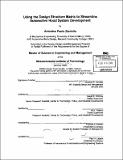| dc.contributor.advisor | Daniel E. Whitney and Ali A. Yassine. | en_US |
| dc.contributor.author | Zambito, Antonino Paolo, 1970- | en_US |
| dc.contributor.other | System Design and Management Program. | en_US |
| dc.date.accessioned | 2005-09-27T20:58:12Z | |
| dc.date.available | 2005-09-27T20:58:12Z | |
| dc.date.copyright | 2000 | en_US |
| dc.date.issued | 2000 | en_US |
| dc.identifier.uri | http://hdl.handle.net/1721.1/29159 | |
| dc.description | Thesis (S.M.)--Massachusetts Institute of Technology, System Design & Management Program, 2000. | en_US |
| dc.description | Includes bibliographical references (leaf 80). | en_US |
| dc.description.abstract | This thesis applies the design structure matrix (DSM) methodology to streamline the automotive hood subsystem development process, addressing the development phases from upstream product strategies to manufacture and assembly. In this analysis, a two-dimensional index called task volatility is used to describe the level of dependency and probability of rework between two tasks. Task volatility is the product of two independent dependency attributes: task sensitivity and information variability. In addition to these dependency data, the models integrate initial costs and durations as well as those associated with rework. This thesis also discusses the concepts of process flexibility and process reliability, and how these attributes can be used together to optimize the product development process. It proposes that iteration is a tradeoff between these attributes, suggesting that optimal process performance can be achieved with a hybrid (reliable / flexible) process. The analysis begins with a baseline process model that describes the current development process. This model is correlated to the actual process by adjusting rework probabilities until the appropriate process duration is obtained. The baseline process model is progressively streamlined through the use of traditional DSM techniques such as task sorting and partitioning. Finally, the baseline model is restructured in the last phase of this analysis using a strategy that leverages currently available technologies to decrease cycle time and rework cost. The refined models are simulated at each step of the analysis. The simulation results are compared to preceding models in order to arrive at a recommended process. | en_US |
| dc.description.statementofresponsibility | by Antonino Paolo Zambito. | en_US |
| dc.format.extent | 80 leaves | en_US |
| dc.format.extent | 4894596 bytes | |
| dc.format.extent | 4894354 bytes | |
| dc.format.mimetype | application/pdf | |
| dc.format.mimetype | application/pdf | |
| dc.language.iso | eng | en_US |
| dc.publisher | Massachusetts Institute of Technology | en_US |
| dc.rights | M.I.T. theses are protected by copyright. They may be viewed from this source for any purpose, but reproduction or distribution in any format is prohibited without written permission. See provided URL for inquiries about permission. | en_US |
| dc.rights.uri | http://dspace.mit.edu/handle/1721.1/7582 | |
| dc.subject | System Design and Management Program. | en_US |
| dc.title | Using the design structure matrix to streamline automotive hood system development | en_US |
| dc.type | Thesis | en_US |
| dc.description.degree | S.M. | en_US |
| dc.contributor.department | System Design and Management Program. | en_US |
| dc.identifier.oclc | 45839422 | en_US |
